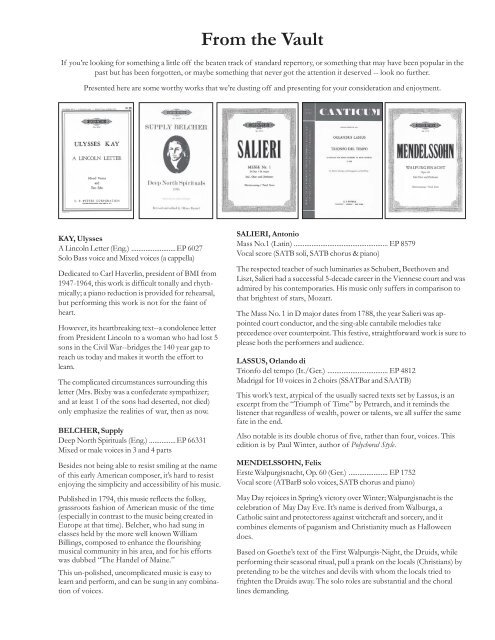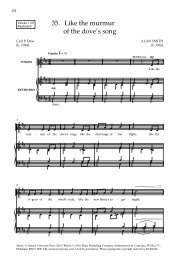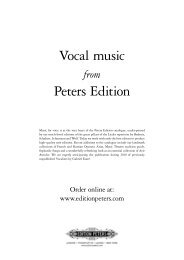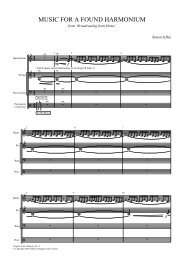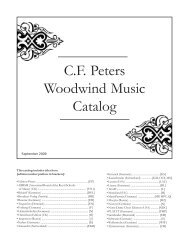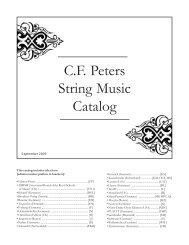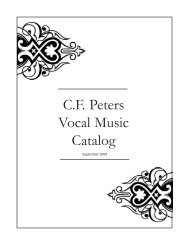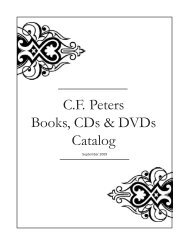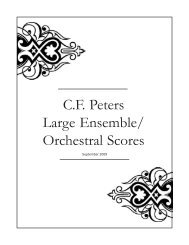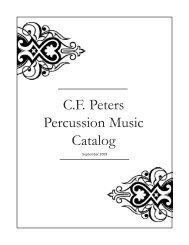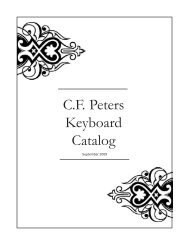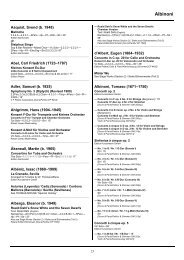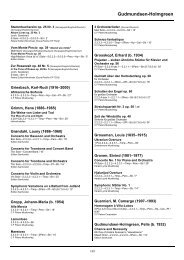C.F. Peters Choral Music Catalog - Peters Edition Ltd
C.F. Peters Choral Music Catalog - Peters Edition Ltd
C.F. Peters Choral Music Catalog - Peters Edition Ltd
You also want an ePaper? Increase the reach of your titles
YUMPU automatically turns print PDFs into web optimized ePapers that Google loves.
From the Vault<br />
If you’re looking for something a little off the beaten track of standard repertory, or something that may have been popular in the<br />
past but has been forgotten, or maybe something that never got the attention it deserved -- look no further.<br />
Presented here are some worthy works that we’re dusting off and presenting for your consideration and enjoyment.<br />
KAY, Ulysses<br />
A Lincoln Letter (Eng.) .........................EP 6027<br />
Solo Bass voice and Mixed voices (a cappella)<br />
Dedicated to Carl Haverlin, president of BMI from<br />
1947-1964, this work is difficult tonally and rhythmically;<br />
a piano reduction is provided for rehearsal,<br />
but performing this work is not for the faint of<br />
heart.<br />
However, its heartbreaking text--a condolence letter<br />
from President Lincoln to a woman who had lost 5<br />
sons in the Civil War--bridges the 140 year gap to<br />
reach us today and makes it worth the effort to<br />
learn.<br />
The complicated circumstances surrounding this<br />
letter (Mrs. Bixby was a confederate sympathizer;<br />
and at least 1 of the sons had deserted, not died)<br />
only emphasize the realities of war, then as now.<br />
BELCHER, Supply<br />
Deep North Spirituals (Eng.) ...............EP 66331<br />
Mixed or male voices in 3 and 4 parts<br />
Besides not being able to resist smiling at the name<br />
of this early American composer, it’s hard to resist<br />
enjoying the simplicity and accessibility of his music.<br />
Published in 1794, this music reflects the folksy,<br />
grassroots fashion of American music of the time<br />
(especially in contrast to the music being created in<br />
Europe at that time). Belcher, who had sung in<br />
classes held by the more well known William<br />
Billings, composed to enhance the flourishing<br />
musical community in his area, and for his efforts<br />
was dubbed “The Handel of Maine.”<br />
This un-polished, uncomplicated music is easy to<br />
learn and perform, and can be sung in any combination<br />
of voices.<br />
SALIERI, Antonio<br />
Mass No.1 (Latin) ..................................................... EP 8579<br />
Vocal score (SATB soli, SATB chorus & piano)<br />
The respected teacher of such luminaries as Schubert, Beethoven and<br />
Liszt, Salieri had a successful 5-decade career in the Viennese court and was<br />
admired by his contemporaries. His music only suffers in comparison to<br />
that brightest of stars, Mozart.<br />
The Mass No. 1 in D major dates from 1788, the year Salieri was appointed<br />
court conductor, and the sing-able cantabile melodies take<br />
precedence over counterpoint. This festive, straightforward work is sure to<br />
please both the performers and audience.<br />
LASSUS, Orlando di<br />
Trionfo del tempo (It./Ger.) .................................. EP 4812<br />
Madrigal for 10 voices in 2 choirs (SSATBar and SAATB)<br />
This work’s text, atypical of the usually sacred texts set by Lassus, is an<br />
excerpt from the “Triumph of Time” by Petrarch, and it reminds the<br />
listener that regardless of wealth, power or talents, we all suffer the same<br />
fate in the end.<br />
Also notable is its double chorus of five, rather than four, voices. This<br />
edition is by Paul Winter, author of Polychoral Style.<br />
MENDELSSOHN, Felix<br />
Erste Walpurgisnacht, Op. 60 (Ger.) ...................... EP 1752<br />
Vocal score (ATBarB solo voices, SATB chorus and piano)<br />
May Day rejoices in Spring’s victory over Winter; Walpurgisnacht is the<br />
celebration of May Day Eve. It’s name is derived from Walburga, a<br />
Catholic saint and protectoress against witchcraft and sorcery, and it<br />
combines elements of paganism and Christianity much as Halloween<br />
does.<br />
Based on Goethe’s text of the First Walpurgis-Night, the Druids, while<br />
performing their seasonal ritual, pull a prank on the locals (Christians) by<br />
pretending to be the witches and devils with whom the locals tried to<br />
frighten the Druids away. The solo roles are substantial and the choral<br />
lines demanding.


